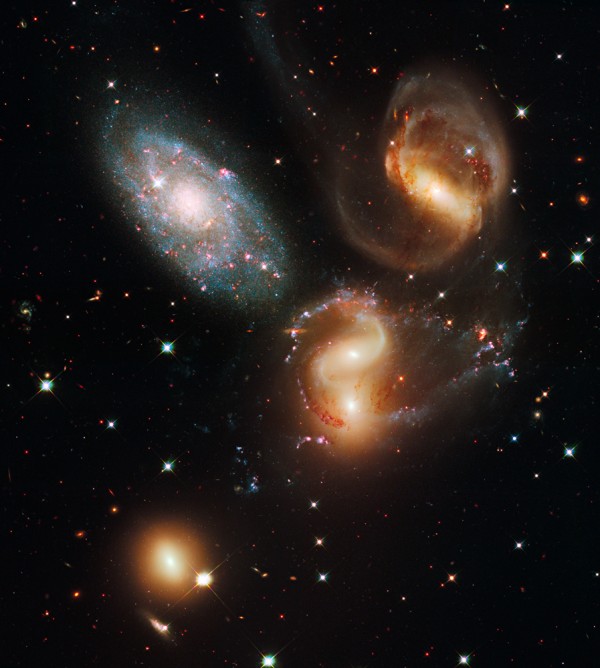Perhaps my favorite of the new Hubble pictures is this one of Stephan's Quintet (and click here for the 1000 pixel wide version):

It's so stunning that it was chosen as today's Astronomy Picture of the Day. But yesterday, I got a very interesting question to go along with it:
These galaxies are far away, and so we're looking at them in the past. What do they look like today, and are there still five of them?
This is a great question. First off, looking at the image, some of you will count only four galaxies. That's because there are two galaxies that are in the process of merging. You can see both galactic nuclei still, and some intense star formation (the white and pink areas) on the outskirts. Most galaxies have their own designation; the three isolated ones are known as NGC 7317, 7319, and 7320. However, these two merging ones are NGC 7318A and NGC 7318B.
Now, the galaxy in the upper left, NGC 7320, is not grouped with the other four. It's simply in the line-of-sight, and is roughly 40 million light-years away. However, the other four are 300 million light-years away, meaning that we're looking at the light that was emitted 300 million years ago.
What do these things look like today? In other words, if we could magically transport ourselves over there, how many galaxies would there be? Four? Three? Two? Just one?
Well, for typical galaxies, it takes over a billion years for two of them to merge completely. But these four have already started merging. Two of them are really close to having merged completely, and in the 300 million years that light has been on its way to us, those two galaxies "caught in the act" are certainly one by now. The one in the upper right will certainly merge eventually, but 300 million years is simply too short a time to see that happen.
And the pretty elliptical one in the lower left? Well, that will certainly take longer than 300 million years to merge, but it's highly likely that numerous galaxies have already merged to form it. Most isolated galaxies are spirals, and most galaxies that undergo mergers become ellipticals. So when we look back on the quintet in two billion years, you'll simply have the foreground galaxy and one large, background, elliptical galaxy. But right now? Over there? There are probably three.
But don't just take my word for it. Check out this video of merging spiral galaxies made by Patrik at UC Santa Cruz:
- Log in to post comments

'Today' is a local term. I find the question about what happens faraway, today, meaningless. Causally-disconnected regions are just... disconnected. I mean, inherently disconnected... What do you think?
So why do the further galaxies look more orange? Is it due to intergalactic dust absorbing the shorter blue wavelengths, or is it a computer generated false colour image? Or some other reason?
First post after lurking for some time.
How violent and fast is this process of merging actually? Although it takes place over a very long period in human perspective, what in terms of speed and time are we talking about in the grand scale of the universe. And how violent is it? Are the two central black holes going to merge and what are the consequences. Also, there is a lot of empty space between stars, but percentage speaking; about how many stars will actually collide or have such an impact on each other that any star that has a planet with a chance of life on it will be affected in such a way that we can assume that life is no longer possible.
I'd like to echo Arjen's question. How would such a merger affect individual stars and their planetary systems? For instance, would we ever see planets 'jumping' from a system to another and live to tell the tale? I realize the odds of this happening would be incredibly slim, but is it even possible? And... does an elliptical galaxy feature more binary stars than another type of galaxy, as a result of previous mergers? Fascinating topic :)
What a great question, and a superb answer! Well done to the questioner.
why are galaxies going to merge?
by what power are galaxies pulled?